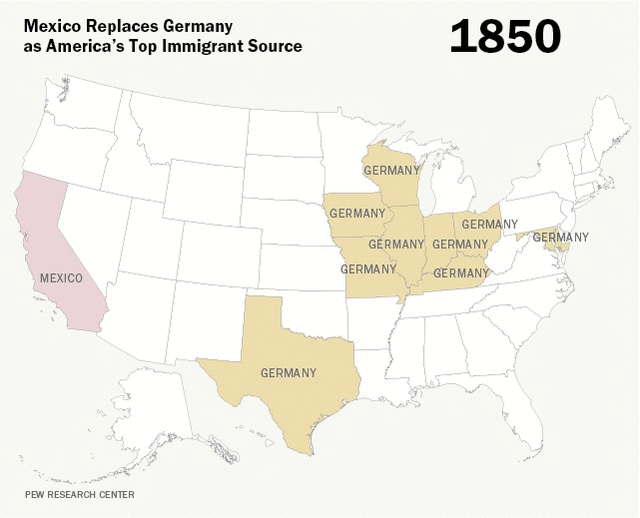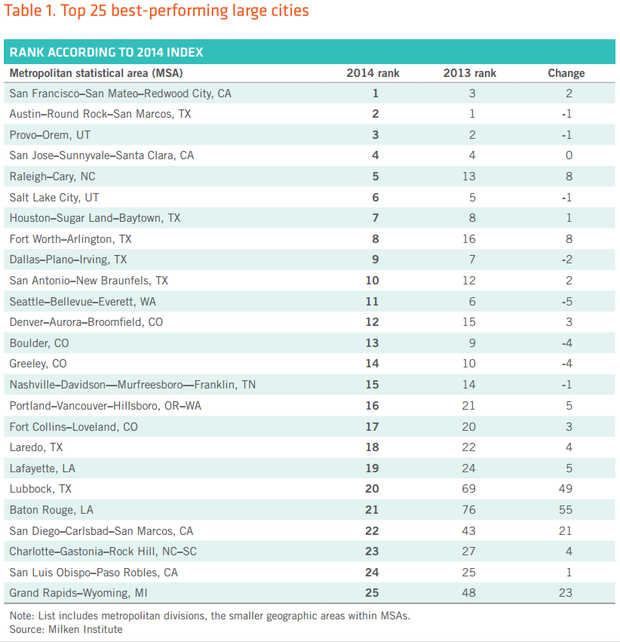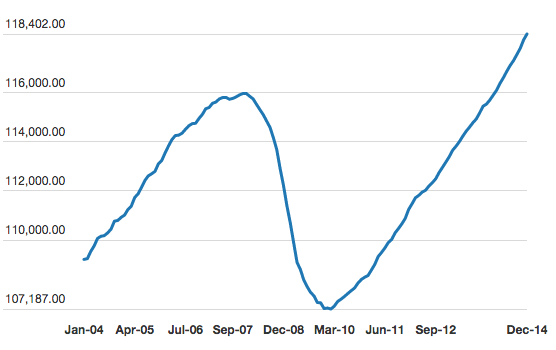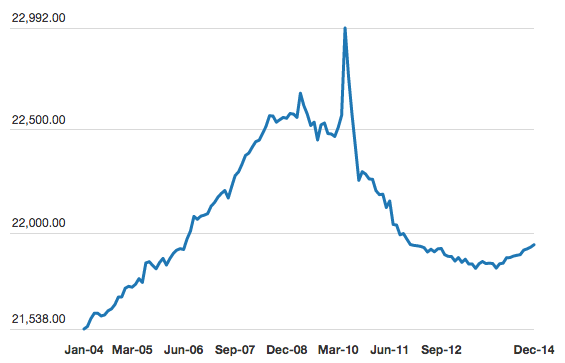Saturday, January 31, 2015
The Logic of Efficiency and Competition
Technology and advancing automation will require businesses to rethink some of their basic equations. Many are no longer valid. Your local and national newspaper have learned this (or should have). Most of the educational system is in the process of learning it. Someone needs to teach our medical system these lessons - - and someday someone like Jeff Bazos will teach them. Researchers have estimated that 50% of the current jobs will be lost to advancing technology and automation. Doing more with less will have a new meaning this century.
In an era marked by concerns about sustainability, the term "sustainable competitive advantage" is truly an oxymoron. Nothing in business is sustainable anymore - flexibility and agility are the new sources of competitive advantage.
As the president of Tara Consulting Services noted - "Anything that can be made to sweat more will be made to sweat more."
In an era marked by concerns about sustainability, the term "sustainable competitive advantage" is truly an oxymoron. Nothing in business is sustainable anymore - flexibility and agility are the new sources of competitive advantage.
As the president of Tara Consulting Services noted - "Anything that can be made to sweat more will be made to sweat more."
Wednesday, January 28, 2015
A New Publication From Arup
Arup does a great job on all their publications - this particular issue is on the critical themes shaping are cities.
Only a Smart City Can Be a Green City
Link to a "Blue Paper" from the Singapore International Water Week 2014 - Link.
Tuesday, January 27, 2015
Resiliency and Social Justice
Engineering needs to be pondering this issue - from the Grist website:
"And, in a resilient society, the burden of risk is shared equally, whether you live in the Lower Ninth Ward or the Upper East Side. That’s not the case in the U.S. today, where low-income people and people of color face disproportionate risks from every kind of environmental problem — from extreme weather events to health impacts from pollution, like asthma. That’s a huge problem for frontline communities. But it’s also a problem for Americans as a whole, because a society that dumps risks on marginalized people is more likely to ignore those risks — until it’s too late. As Naomi Klein has observed, “once decision-makers start rationalizing the sacrificing of some lives, it’s awfully hard to stop.”"
"And, in a resilient society, the burden of risk is shared equally, whether you live in the Lower Ninth Ward or the Upper East Side. That’s not the case in the U.S. today, where low-income people and people of color face disproportionate risks from every kind of environmental problem — from extreme weather events to health impacts from pollution, like asthma. That’s a huge problem for frontline communities. But it’s also a problem for Americans as a whole, because a society that dumps risks on marginalized people is more likely to ignore those risks — until it’s too late. As Naomi Klein has observed, “once decision-makers start rationalizing the sacrificing of some lives, it’s awfully hard to stop.”"
Monday, January 26, 2015
Sunday, January 25, 2015
Which Engineering Discipline Produces the Most Welding Jobs?
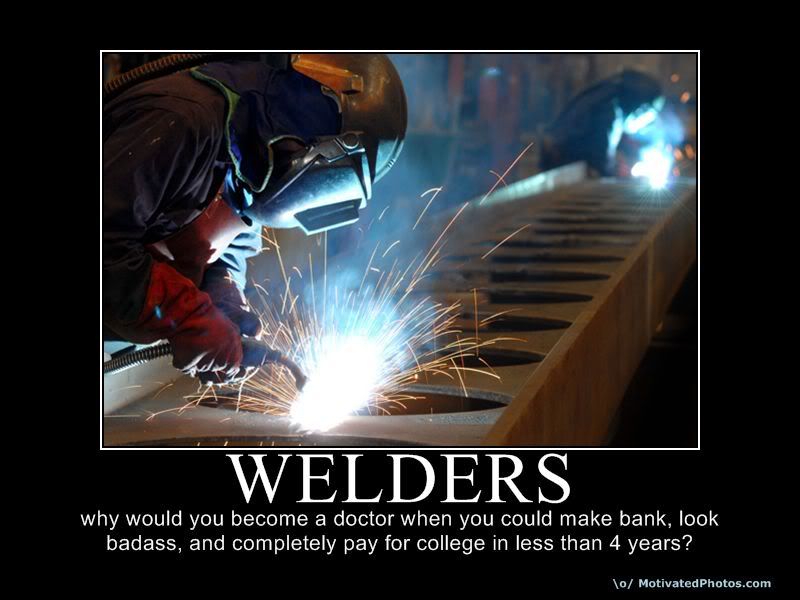 From newgeography - U.S. Economy Needs Hardhats Not Nerds. The issue of many of our most successful technology companies (i.e., Facebook, Google, Zapppo, etc.) not producing enough quality middle class jobs is one of our most critical public policy issues. Engineering is directly in the middle of the issue - - the "glamour" and wealth of many parts of engineering versus the middle class job producing potential of the "old" parts of engineering.
From newgeography - U.S. Economy Needs Hardhats Not Nerds. The issue of many of our most successful technology companies (i.e., Facebook, Google, Zapppo, etc.) not producing enough quality middle class jobs is one of our most critical public policy issues. Engineering is directly in the middle of the issue - - the "glamour" and wealth of many parts of engineering versus the middle class job producing potential of the "old" parts of engineering.From the article:
"Nor is the current ephemera the key to new productivity growth. Social media may be fun, but it is not making America more competitive or particularly more productive (PDF). Yet there has been strong innovation in “production” sectors such as manufacturing, which alone accounts for roughly half (PDF) of all U.S. research and development.
What is frequently missed is that engineering covers a lot of different skills. To be sure the young programmers and digital artists are important contributors to the national economy. But so too are the many more engineers who work in more mundane fields such as geology, chemical, and civil engineering. Houston, for example, ranks second (PDF) behind San Jose in percentage of engineers in the workforce, followed by such unlikely areas as Dayton and Wichita. New York, on the other hand, has among the lowest percentage of engineers of major metropolitan areas.
To be sure, an aerospace engineer in Wichita is not likely to seem as glamorous as the youthful, urbanista app-developers so lovingly portrayed in the media. Yet these engineers are precisely the people, along with skilled workers, who keep the lights on, planes flying and cars going, and who put most of the food on people’s tables.
The dissonance between reality and perception is most pronounced in California. The state brags much about the state’s renewable sector to the ever gullible media. But in reality high subsidized solar and wind account for barely 10 percent ofelectrical production, with natural gas and coal, now mostly imported from points east, making up the vast majority. In terms of transportation fuels, the state has a96 percent dependence on fossil fuels, again large imported, despite the state’s vast reserves. Los Angeles, although literally sitting on oil, depends for 40 percent of its electricity on coal-fired power from the Intermountain West."


Saturday, January 24, 2015
Traffic Engineering and the Pletzman Effect
Engineering needs to develop a closer professional relationship with behavioral psychologist and economist. Excellent story on what engineers and planners viewed as safer and wiser - - the driving public took it as a signal to "consume" the safety improvements and risk reduction.
More on the Pletzman Effect.
More on the Pletzman Effect.
Shore Up
 This is a good example of innovative thinking in the age of resiliency planning - Shore Up from Connecticut. From the website:
This is a good example of innovative thinking in the age of resiliency planning - Shore Up from Connecticut. From the website:
Shore Up CT is a state of Connecticut funded low-interest loan program which provides financing for property owners in coastal municipalities located in Flood Zones VE or AE to finance or refinance property elevations. Additional retrofitting for flood protection and wind proofing activities can also be financed.
Loan Terms:
- 2.75 % fixed interest rate (2.894% APR*)
- 1% origination fee
- Borrow $10,000 to $300,000 with 15 year term
- No monthly principal or interest payments for the first 12 months
- Borrower must maintain property, hazard, and flood insurance for the life of the loan
A Paragraph to Ponder
From a special report in the Economist (January 17th, 2014) - Invisible Fuel: Energy Efficiency:
"The "fifth fuel", as energy efficiency is sometimes called, is the cheapest of all. A report by ACEER, an American energy-efficiency group, reckons that the average cost of savings a kilowatt hour is 2.8 cents; the typical retail cost of one in America is 10 cents. In the electricity-using sector, saving a kilowatt hour can cost as little as one-sixth of a cent, says Mr. Lovins of Rocky Mountain Institute, so payback can be measured in months, not years,"
"The "fifth fuel", as energy efficiency is sometimes called, is the cheapest of all. A report by ACEER, an American energy-efficiency group, reckons that the average cost of savings a kilowatt hour is 2.8 cents; the typical retail cost of one in America is 10 cents. In the electricity-using sector, saving a kilowatt hour can cost as little as one-sixth of a cent, says Mr. Lovins of Rocky Mountain Institute, so payback can be measured in months, not years,"
Deepwater Horizon: The Movie

From writer/director J.C. Chandor (link to the current status of the movie) - his most recent film is A Most Violent Year.
Friday, January 23, 2015
"To create a sustainable business model, you have to have growth"
Great article on the current state of the newspaper - Newsonomics. From the article:
"Dallas Morning News publisher Jim Moroney makes that point often and succinctly: “How do you deal with all of that? To create a sustainable business model, you have to have growth.” In other words, simply managing decline of the print business won’t get your there. Without new revenue, the sad shrinkage of America’s local news pipeline will continue."
"Dallas Morning News publisher Jim Moroney makes that point often and succinctly: “How do you deal with all of that? To create a sustainable business model, you have to have growth.” In other words, simply managing decline of the print business won’t get your there. Without new revenue, the sad shrinkage of America’s local news pipeline will continue."
Wednesday, January 21, 2015
The Qualified Public Infrastructure Bond Program
From the State of the Union Address last night - information on the program.
Also from last night - can 60 words make a difference.
“Twenty-first century businesses need 21st century infrastructure—modern ports, and stronger bridges, faster trains and the fastest internet,” Obama said. “Democrats and Republicans used to agree on this. So let's set our sights higher than a single oil pipeline. Let's pass a bipartisan infrastructure plan that could create more than thirty times as many jobs per year, and make this country stronger for decades to come.”
Also from last night - can 60 words make a difference.
“Twenty-first century businesses need 21st century infrastructure—modern ports, and stronger bridges, faster trains and the fastest internet,” Obama said. “Democrats and Republicans used to agree on this. So let's set our sights higher than a single oil pipeline. Let's pass a bipartisan infrastructure plan that could create more than thirty times as many jobs per year, and make this country stronger for decades to come.”
Tuesday, January 20, 2015
I Quant NY
Fascinating website - the world of the quant in our open-sourced society bringing data to many of our more difficult and complex issues and problems is going to drive an entire species of pre-technological politicians nuts. But the "solution bureaucracy" needs to tap into and help build a public exchange based on data driven problem solving.
Monday, January 19, 2015
AECOM and Diseconomies of Scale
What about a couple of issues to ponder in the age of the super-AE firms. Several things could be happening that are interesting. Companies, like a AECOM, are difficult to manage effectively. When you see a company with many business lines - are we actually looking at CEO ego gain and shareholder wealth loss? True or false. Or we actually live in a world of tremendous fixed costs to developing a good decision-making structure and CEO talent is scarce. The CH2M-Hill's and AECOM's super managers or management super cultures can handle a 15th line of business more effectively than other managers can handle the first or fifth. True or false.
Reslience and the Need for Morphological Placticity
Organizations across the globe this century face a similar question - how to build resilience in a fragile world. The main strategic challenge that most organization face is building resilience for long-term sustainability. Building resilience - the ability to bounce back more quickly and effectively - is an urgent social and economic issue that engineers will face this century. As we have all seen, our interconnected world is susceptible to sudden and dramatic shocks stresses - ranging from a cyber-attack to a new strain of virus to terrorism to infrastructure failures to a violent storm to an economic blow to civil disturbances.
One way to look at organizational resilience is to look at the plant that gives us cotton. The epic story of cotton is one of a plant that is stubborn, seemingly able to thrive with little help from farmers, given the right natural conditions. It grows in a wide range of environments thanks to its "morphological plasticity" - its ability to adapt to diverse growing conditions by shortening, lengthening, or even interrupting its effective bloom period,
When assessing the resiliency of your organization, the five characteristics of resilience are a good place to start - awareness, diversity, integration, self-regulation, and adaptive are a good place to start. Under adaptive, also start thinking about the level of "morphological plasticity" your organization has and needs for a century of constant change and disruption.

One way to look at organizational resilience is to look at the plant that gives us cotton. The epic story of cotton is one of a plant that is stubborn, seemingly able to thrive with little help from farmers, given the right natural conditions. It grows in a wide range of environments thanks to its "morphological plasticity" - its ability to adapt to diverse growing conditions by shortening, lengthening, or even interrupting its effective bloom period,
When assessing the resiliency of your organization, the five characteristics of resilience are a good place to start - awareness, diversity, integration, self-regulation, and adaptive are a good place to start. Under adaptive, also start thinking about the level of "morphological plasticity" your organization has and needs for a century of constant change and disruption.

Sunday, January 18, 2015
Glossary of Science Fiction Ideas, Technology, and Inventions
The link to the site.
Networking - Making an Unnatural Act More Natural
To the vast majority of engineers, the art and science of networking is an unnatural act. This is unfortunate is a world driven by the network - where your contacts = contracts. The Schumpeter column in The Economist this week has an excellent treatise on the power and promise of the network effect. From the column:
"But shamelessness needs to be balanced with subtlety. Pretend to disagree with your interlocutor before coming around to his point of view; that gives him a sense of mastery. Discover similar interests or experiences. People are so drawn to those like themselves that they are more likely to marry partners whose first or last names resemble their own. Go out of your way to ask for help. Lending a helping hand allows a powerful person to exercise his power while also burnishing his self-esteem. In his time in the Senate, in 2005-08, Barack Obama asked about a third of his fellow senators for help and advice.
The second principle is that you must have something to say. Success comes from having a well-stocked mind, not just a well-thumbed Rolodex. It is tempting to treat the conference’s official topic as a bit of a joke. Wrong. The more seriously you take it, the more you will succeed in your, and the gathering’s, true purpose. Go to the main sessions and ask sensible questions. Reward the self-styled “thought leaders” in each session by adding them to your Twitter “follow” list. But don’t get carried away. It is a mistake to lecture people on your own pet subjects, as this columnist has discovered. It is an even bigger mistake to question the shibboleths of the global elite. There is a case to be made that homogeneous organisations can do better than ones with diverse workforces, for example. But don’t go there. The aim is to fit in by saying the right things, not to challenge the received wisdom.
The third principle is that you need to work hard at networking. Swot up in advance on the most important people who will be at an event. If you manage to meet them, follow up with an e-mail and a suggestion to meet again. Mukesh Ambani, the boss of Reliance Industries, one of India’s largest conglomerates, makes sure that he is briefed on people he is about to meet, and asks them about their interests. Mark Tucker, the boss of AIA, one of Asia’s biggest insurers, follows up conversations with detailed e-mails, sent at all times of the day and night. Julia Hobsbawm of Editorial Intelligence, a firm which coaches executives on how to network, says that it is like exercise and dieting. You need to incorporate it into your daily routine."
Prediction For 2015 - Peak Oil
Interesting prediction for 2015:
"Peak Oil: I predict that global oil production (conventional and shale etc) will decline in 2015 and will never again reach the peak level of 2014. My reasoning is that 2014 supply can’t be sustained at prices below, say, $75, and (given a downward underlying trend in the developed world), 2014 demand won’t be reached again at prices above $75."
"Peak Oil: I predict that global oil production (conventional and shale etc) will decline in 2015 and will never again reach the peak level of 2014. My reasoning is that 2014 supply can’t be sustained at prices below, say, $75, and (given a downward underlying trend in the developed world), 2014 demand won’t be reached again at prices above $75."
New USEPA Water Infrastructure and Resiliency Finance Center
Press release from the EPA:
"WASHINGTON - The U.S. Environmental Protection Agency launched the Water Infrastructure and Resiliency Finance Center today to help communities across the country improve their wastewater, drinking water and stormwater systems, particularly through innovative financing and by building resilience to climate change. The center was announced as Vice President Biden and EPA Administrator Gina McCarthy toured the construction site for a tunnel to reduce sewer overflows into the Anacostia River in Washington, D.C. by 98 percent. The center is part of the White House Build America Investment Initiative – a government-wide effort to increase infrastructure investment and promote economic growth by creating opportunities for state and local governments and the private sector to collaborate, expand public-private partnerships, and increase the use of federal credit programs.
“Infrastructure is central to the President’s plan to build on the progress the U.S. economy is making by creating jobs and expanding opportunity for all Americans,” said EPA Administrator Gina McCarthy. “By modernizing the nation’s infrastructure we can protect our drinking water sources and enhance resilience to the impacts of climate change by avoiding financial and water supply losses from leaking pipes and reducing pollution from sewer overflows and wastewater discharges.”"
"WASHINGTON - The U.S. Environmental Protection Agency launched the Water Infrastructure and Resiliency Finance Center today to help communities across the country improve their wastewater, drinking water and stormwater systems, particularly through innovative financing and by building resilience to climate change. The center was announced as Vice President Biden and EPA Administrator Gina McCarthy toured the construction site for a tunnel to reduce sewer overflows into the Anacostia River in Washington, D.C. by 98 percent. The center is part of the White House Build America Investment Initiative – a government-wide effort to increase infrastructure investment and promote economic growth by creating opportunities for state and local governments and the private sector to collaborate, expand public-private partnerships, and increase the use of federal credit programs.
“Infrastructure is central to the President’s plan to build on the progress the U.S. economy is making by creating jobs and expanding opportunity for all Americans,” said EPA Administrator Gina McCarthy. “By modernizing the nation’s infrastructure we can protect our drinking water sources and enhance resilience to the impacts of climate change by avoiding financial and water supply losses from leaking pipes and reducing pollution from sewer overflows and wastewater discharges.”"
Saturday, January 17, 2015
Hunting Down Other Drones
The battle of the drones is starting - link.
Moving From Siloing to Meshing
Most of the world fully understands this simple fact. Gone are the days when you could separate various academic and professional disciplines into tidy little boxes. Engineering has been slower than other professions and parts of the economy to accept this fact - we still like our little boxes of codified information and practices in order to make sense of our messy world. But here is the thing that engineering needs to get on board with - our global landscape has grown much too complex for such an outdated approach, requiring instead a merging of disciplines.
Nothing says "meshing" more than global warming and climate change. As reported this week, 2014 broke another heat record. As the New York Times reported today, the 10 warmest years have all occurred since 1987, a reflection of the relentless planetary warming that scientists say is a consequence of human activity and poses profound long-term risk to civilization and nature. No one engineering discipline or practice area will have all the answers to the global warming and climate change questions. What will be required is a new way to think, organize, and manage the colliding of information, domains, tools, ideas, practices, and philosophies that were previously deemed exclusive and untouchable.
Another "wicked" problem is our declining infrastructure and the need for smarter and more resilient bridges, water treatment plants, and dams. Civil engineering will not have all the answers to a world demanding smarter infrastructure - nor will computer science and engineering. What offers our clients and communities the deepest solutions are the "spaces-in-between" the worlds of civil engineering and computer science. The biggest boast we can give to future engineers is helping them to develop transformative mindsets that seek out new and creative solutions to old problems in a world of transdisciplinary meshing.
Your success this century as an engineer depends on your ability to forget siloing and think about the merging of disciplines.
Nothing says "meshing" more than global warming and climate change. As reported this week, 2014 broke another heat record. As the New York Times reported today, the 10 warmest years have all occurred since 1987, a reflection of the relentless planetary warming that scientists say is a consequence of human activity and poses profound long-term risk to civilization and nature. No one engineering discipline or practice area will have all the answers to the global warming and climate change questions. What will be required is a new way to think, organize, and manage the colliding of information, domains, tools, ideas, practices, and philosophies that were previously deemed exclusive and untouchable.
Another "wicked" problem is our declining infrastructure and the need for smarter and more resilient bridges, water treatment plants, and dams. Civil engineering will not have all the answers to a world demanding smarter infrastructure - nor will computer science and engineering. What offers our clients and communities the deepest solutions are the "spaces-in-between" the worlds of civil engineering and computer science. The biggest boast we can give to future engineers is helping them to develop transformative mindsets that seek out new and creative solutions to old problems in a world of transdisciplinary meshing.
Your success this century as an engineer depends on your ability to forget siloing and think about the merging of disciplines.
Friday, January 16, 2015
Advanced Empathy for Design Engineers 200
No engineer has ever taken a class call "Developing Empathy 101" or "Advanced Empathy for Design Engineers 200." Rarely are design classes organized and taught around the the goal of developing a deep understanding of customer/client and user needs. Getting educators and engineers on the empathy bandwagon requires a basic interest in, curiosity about and empathy for customers/clients, to elicit and capture their stories.
One core axiom of engineering never changes - the ability to put yourself in another's shoes is critical to framing a problem so it can be solved. This requires engineers to have the "divergent" learning style - the ability to look at things from different perspectives. This forces engineers to be sensitive - engineers that want to watch rather do, tending to gather information and imagination to solve problems. These engineers should have broad cultural interests and are interested in people. They like to work in groups and listen with an open mind.
Human-centered design will require organizations to find and train more divergent learners and thinkers.

One core axiom of engineering never changes - the ability to put yourself in another's shoes is critical to framing a problem so it can be solved. This requires engineers to have the "divergent" learning style - the ability to look at things from different perspectives. This forces engineers to be sensitive - engineers that want to watch rather do, tending to gather information and imagination to solve problems. These engineers should have broad cultural interests and are interested in people. They like to work in groups and listen with an open mind.
Human-centered design will require organizations to find and train more divergent learners and thinkers.

Thursday, January 15, 2015
Too Many Parking Lots
From the Atlantic Online - Just Because You Can't Find a Place to Park Doesn't Mean There Aren't Way Too Many Parking Spots:
"On average across the cases, parking supply exceeded demand by 65 percent."
"On average across the cases, parking supply exceeded demand by 65 percent."
Wednesday, January 14, 2015
Tuesday, January 13, 2015
Valor Water Analytics
Interesting company and potential market. The world of big data and analytics is looking at the water industry as a huge market.


Black & Veatch Has An Excellent White Paper
B&V recently published a write paper, The Smart Revolution: Smart Integrated Infrastructure, that is excellent at describing the ongoing smart revolution in the context of the urban infrastructure landscape (link to the paper). The future is rapidly become a race to see how innovative software applications, decentralized information networks, sensor technologies, and advanced communications will interface and enhance the world of grey infrastructure.
What would you do to persuade your staff to work if you couldn't pay them?
One of the good thought provoking management questions. How you nurture engagement, especially with the Millennials, is critical to preventing a team that is physically present but mentally elsewhere. Too often organizations are focused 100% on leading and managing around the "cash nexus" and are clueless in terms of developing a psychological contract around a shared purpose and organizational citizenship.
Monday, January 12, 2015
Sunday, January 11, 2015
Saturday, January 10, 2015
The Curapipe System
Curapipe System is another in the army of high-tech water companies that comes from Israel. Curapipe System offers an automated leak repair system that plugs ruptures without diggings.
The Best Marine Salvage Master In the World
The December issue of Vanity Fair has an excellent profile of marine salvage master Captain Nick Sloane. From the article:
"Most recently he directed the removal of the Costa Concordia, the Italian cruise ship that ran aground and capsized in 2012 off the Tuscan island of Giglio, with the loss of 32 lives. For more than two years he stayed on the island, managing a team of as many as 530 people to roll the enormous ship upright and attach external flotation tanks in order to refloat it and tow it away to be scrapped. It was the most expensive such effort in history, with a budget of more than $1 billion, and it paid Sloane well. Nonetheless, in the end it was just a wreck removal, performed on the basis of a tedious cost-plus contract and requiring soul-deadening feats of bureaucratic wrangling. Last I checked, Sloane had 84,000 e-mails in his Concordia in-box, of which only 2,500 remained unread. The routine was hard on him. Speculative salvage is what he prefers. He is an adventurer at heart."
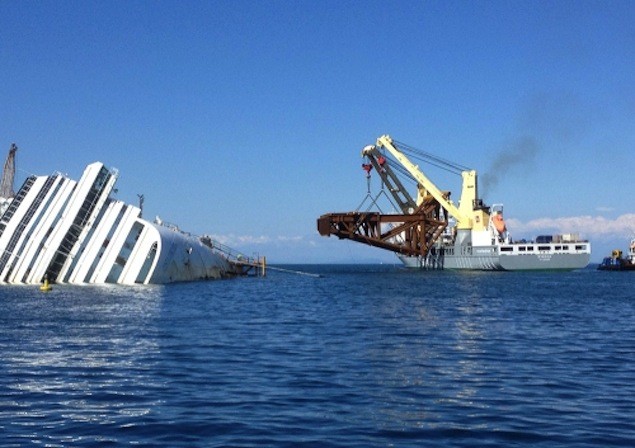
"Most recently he directed the removal of the Costa Concordia, the Italian cruise ship that ran aground and capsized in 2012 off the Tuscan island of Giglio, with the loss of 32 lives. For more than two years he stayed on the island, managing a team of as many as 530 people to roll the enormous ship upright and attach external flotation tanks in order to refloat it and tow it away to be scrapped. It was the most expensive such effort in history, with a budget of more than $1 billion, and it paid Sloane well. Nonetheless, in the end it was just a wreck removal, performed on the basis of a tedious cost-plus contract and requiring soul-deadening feats of bureaucratic wrangling. Last I checked, Sloane had 84,000 e-mails in his Concordia in-box, of which only 2,500 remained unread. The routine was hard on him. Speculative salvage is what he prefers. He is an adventurer at heart."

Project Management Soft Skill Tip #4
All managers, especially project managers, need to constantly focus on improving their listening skills. Nothing says "I heard you" more than telling people what they just told you. The best way not only to show you have listened to your project team, but really do to so, is to repeat their views in good faith back to them. This not only works in project team settings, it works in all relationships - with your children, clients, and spouses. After views have been expressed, summarize the strands of opinion for everyone. It will help you decide and it will help rally the team - even those who disagree with your decision.
Friday, January 9, 2015
All Texans Should Read This Article
From the New Yorker - How California Bested Texas.
The Need to Cultivate Resilience
A good source for some of the latest tools and research of the subject of resiliency - the Center for Resilience at the Ohio State University.
Should All Engineers Become Engineers?
A paragraph to ponder from the Wall Street Journal on January 8, 2015 in an article by James Hagerty - The Life of a $140,000-a-Year Welder:
"Instead, he attended Texas State Technical College in Waco, and received a two-year degree in welding. In 2013, his first full year as a welder, his income was about $130,000, more than triple the average annual wages for welders in the U.S. In 2014, Mr. Friend's income rose to about $140,000."
"Instead, he attended Texas State Technical College in Waco, and received a two-year degree in welding. In 2013, his first full year as a welder, his income was about $130,000, more than triple the average annual wages for welders in the U.S. In 2014, Mr. Friend's income rose to about $140,000."
Thursday, January 8, 2015
The Importance of Trust
Engineers, especially those involved in the public sector, must function under the microscope of public trust. Trust between owners and engineers is the glue that holds the entire profession together. Without public trust and our personal relationships with key stakeholders, the system of quality infrastructure sort of grinds to a halt.
Incoming UT Chancellor McRaven gets at the importance of trust during an interview with the Texas Tribune:
McRaven: It’s about establishing trust. My job really is to be the CEO of the UT System. I have to be able to have trust between the board of regents and myself. They’ve got to trust me to do the job. And then, frankly, I’ve got to build the trust between the presidents of the institutions and myself. And it starts with me.
I believe it is all about making sure I am trustworthy. The way you do that is all about building personal relationships. You have to meet people. They have to know that you have a wife and kids and what your desires are, what your goals are. Because if you have no personal relationship with these people, then when the times get tough, it’s really hard to trust them.
There are going to be some hard decisions that have to be made. But if you make the hard decisions and people trust you because you have that personal relationship, it’s going to make the outcome all that much easier. So, job one is to build trust, which is what I intend to do. I think if you do that, we’ll get past these.
We have to resolve these. I’m not saying the disputes are wrong. I’m just saying we have to resolve them and move on.
Subscribe to:
Comments (Atom)






